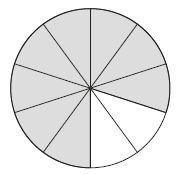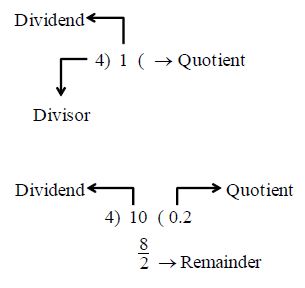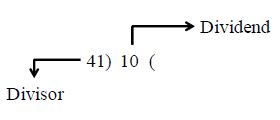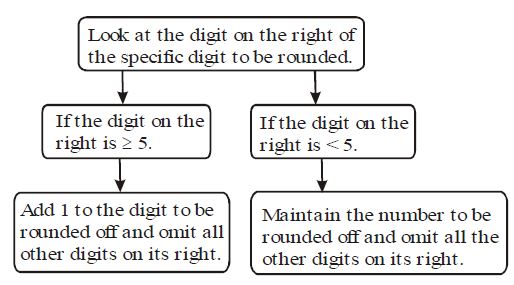1. DECIMALS AND DECIMAL FRACTIONS
Representing fractions of and as decimals and vice versa
Decimals are fractions whose denominator is a multiple of 10, that is 10, 100, 1,000, …. and so on.
In the figure below, the shaded areas represent 8 of 10 parts, that is parts. 
1 of 10 parts =
Hence, decimals and fractions are interchangeable.
Representing fractions with denominators 10, 100 and 1,000 as decimals
Any fractions with denominators 10, 100 and 1,000 can be expressed in decimals.
How to read and write decimals to thousandths?
2. PLACE VALUE CHART OF DECIMALS
The place-value chart of decimals as shown below
|
Ten Thousands |
Thousands |
Hundreds |
Tens |
Ones |
Decimal Point |
Tenths |
Hundredths |
Thousandths |
|
10000 |
1000 |
100 |
10 |
1 |
|
We arrange a decimal number 3526.812 in the place value chart as follows.
|
Thousands |
Hundreds |
Tens |
Ones |
Decimal Point |
Tenths |
Hundredths |
Thousandths |
|
1000 |
100 |
10 |
1 |
|
|||
|
3 |
5 |
2 |
6 |
|
8 |
1 |
2 |
Therefore place value of 3 = 3000
place value of 5 = 500
place value of 2 = 20
place value of 6 = 6
place value of 8 = = 8 tenths
placer value of 1 = = 1 hundredths
place value of 2 = = 2 thousandths
Therefore the expanded form of 3526.812 is 3526.812 = 3000 + 500 + 20 + 6 + .
Here 3526.812 is called ordinary or short form.
3. DECIMAL PLACES
The number of digits in the decimal part of a decimal gives the number of its decimal places.
Example:
4.25 has two decimal places
6.125 has three decimal places
4.6 has only one decimal place
4.0 has no decimal place
Classification of Decimals according to its Decimal Places
There are two types of decimals according to its decimal places, they are
(i) Like decimals (ii) Unlike decimals
Like Decimals
Decimals having the same number of decimal places are called like decimals.
Example: 4.25, 6.75, 10.02 are like decimals.
Unlike Decimals
Decimals having different number of decimal places are called unlike decimals.
Example: 4.2, 4.25, 5.625 etc are unlike decimals
Important Result:
For decimal 0.2, 0.20, 0.200
Case(i) and
. therefore 0.2 = 0.20
Case(ii) Now and therefore 0.20 = 0.200
From case (i) & (ii) we have 0.2 = 0.20 = 0.200 = … etc
Therefore on putting any number of zero’s to the extreme right side of the decimal part of a decimal does not change the value of the decimal. We can write 4.12 = 4.120 = 4.1200 etc. In this way we may convert unlike decimals into like decimals.
Terminating or Non-Terminating Decimals
Terminating Decimals: If the digits coming after decimal point are finite, then it is called terminating decimal with terminal place. These decimals are called terminating decimals or decimals with an end.
Example:
4.5, 4.25, 1.52512, 32.3335 etc are terminating decimals.
Non-Terminating Decimals
If one or more digits in a decimal part of a decimal are repeated again and again without any end, they are called non-terminating decimals.
Example:
(i)
(ii)
(iii) 1.732732732…etc are non-terminating decimals
The digit/s which are repeated again and again without any end in a decimal is called the ‘limit’ of the decimal.
In above example
(i) The limit of 1.732732 ….. is 732
(ii) The limit of 0.333 …. is 3
(iii) The limit of 0.9090 …. is 90
While representing non-terminating decimals we can write a line on the digits which are repeated continuously. From above examples
(i) can be written as 0.3
(ii) can be written as
(iii) 1.73273….. can be written as
4. INTER-CONVERSION OF DECIMAL AND FRACTIONS
I. Decimal to Fraction
Write decimal fractions without decimal point as the numerator of the fraction
Now write 1 followed by as many zeros as there are as many digits after decimal point as the denominator of the fraction.
Now write the simplest form of fraction so obtained
Examples:
(i) , Hence after decimal point there are two digits.
(ii)
(iii) There are three digits after decimal place.
II. Fraction into a Decimal
We convert a general fractions into a decimal by division method as follows:
When a given fraction is a proper fraction
Example:
Find into decimal
Given fraction is proper fraction, denominators does not divides numerator
Step1:
Plot decimal point in quotient and put a zero on a right of the dividend then divide it just as whole number.
Step2:
If we get non-zero remainder, then put a zero on a right of the remainder and then check whether it is divided by divisor or not, if it is divisible then divide by actual division.
Continue this process until getting remainder zero and quotient is required decimal for given fraction.
Step 3:
If the number so obtained in (Step2) above step is not divided by divisor, then put another zero as a right of the remainder, as well as put a zero on right of the quotient also, then check whether it is divisible by divisor. It is divisible then follow actual divisor otherwise continue Step3. Continue this process until getting remainder zero. Now the quotient is required decimal the following examples explains Step3
Example:
Convert into decimal

Step1:
Step2 :
Step3 :
Here 11 does not divides 10
Step4 :
If the same remainder coming repeatedly then terminate the process and write quotient as required decimal.
In above, the remainder 1 repeats continuously so that the division terminates at same end. Therefore the required decimal is non-terminating decimal. Therefore
III. Improper or Mixed Fraction into a Decimal
If a given fraction is mixed, then convert it into proper fraction. Then follow the following steps.
Step1:
Divide the dividend by divisor using actual division, then we get quotient as well as non-zero remainder which is not divided by divisor. Now we follow the steps which are given for conversion of proper fractions into decimal.
Examples:
Convert into decimal
Given mixed fraction =
By actual division, we have
Step1:
Step2:
5. COMPARISON OF DECIMALS
To compare two or more decimals, we take the following steps.
Step1:
First we convert the given decimals into like decimals
Step2:
Now compare the whole number parts, the decimal with the greater whole number part is greater
Step3:
If the whole parts are equal, compare the tenths digits. The decimal with the greater digit in the tenths place is greater.
Step4:
If the tenths digits are also equal, compare the hundredths digits, continue this process until getting unequal digits.
Examples:
Compare 76.82 and 58.70
First compare whole number parts clearly 76 > 58
Compare 2.78 and 2.52, here whole number parts are equal now compare the digits at tenths place.
Clearly 7 > 5. Therefore 2.78 > 2.52
Compare 32.416 and 32.418
Here the whole number parts and the digits at tenths, hundredths places are equal, now compare digits at thousandths place clearly 8 > 6
Therefore 32.418 > 32.416
6. ASCENDING OR DESCENDING ORDER OF DECIMALS
The arrangement of decimals from smaller decimal to greater decimal is called ascending order of decimals. It can be done by comparison of decimals. The arrangement of decimals from greater decimal to smaller decimal is called descending order of decimals. It can be done by comparison of decimals.
Examples:
Arrange 5.37, 3.57, 3.5, 5.3, 5.7, 3.07 in ascending and descending order. Given decimals can be written as like decimals 5.37, 3.57, 3.50, 5.30, 5.70, 3.07; first we compare the decimals whose whole number parts are equal.
Clearly 3.07 < 3.50 < 3.57 and 5.30 < 5.37 < 5.70
Now compare 3.57 and 5.30 clearly 3 < 5
Therefore 3.57 < 5.30
Hence 3.07 < 3.50 < 3.57 < 5.30 < 5.37 < 5.70
Therefore the ascending order is 3.07, 3.50, 3.57, 5.30, 5.37, 5.70 and the descending order is 5.70, 5.37, 5.30, 3.57, 3.50, 3.07.
Rounding off decimals
The decimal place (d.p.) of a decimal is the number of digits to the right of the decimal point.
A decimal can be rounded off, correct to a certain number of decimal places (d.p.).
The method of rounding off a decimal is similar to the method of rounding off a whole number.
To round off a decimal to a specific number of decimal places:
7. FOUR FUNDAMENTAL OPERATIONS (+, -, ×, ÷) ON DECIMALS
I. Addition
First convert the given decimals into like fractions.
Now write the addends one under the other in column form so that the decimal points of all addends are in the same column and the digits at the same place are in the same column
Now add decimals as actual addition and then put decimal point directly under the decimal points in the addends
Examples: Add 5.6, 3.59, 12.56, 123.56.
First convert all decimals into like decimals 5.600, 3.590, 12.056, 123.560
Therefore the sum of given decimals is 144.806
II. Subtraction
To subtract one decimal from other, first convert the given decimals into like decimals.
Write smaller decimals under greater decimal in column form, so that decimal points of the both the decimals are in the same column. Now subtract decimals by using actual subtract and then put decimal point directly under the decimal points of the given numbers.
Example:
Subtract 12.56 from 25.3
First convert given decimals into like decimals
12.56, 25.30 are like decimals 25.3 – 12.56 =12.74
Subtract 26.568 from 128.70
26.568, 128.700 are like decimals 128.7 – 26.568 = 102.132
III. Multiplication
Multiplication by a Whole Number
Multiply the decimal without the decimal point by the whole number.
Place the decimal point so as to obtain as many decimal places in the product as there are in the decimal number.
Examples:
Multiply 5.36 by 12
First we multiply 536 by 12
The given decimal number has 2 decimal places
Therefore 5.36 x 12 = 64.32
Multiplication by 10, 100 and 1000
When a decimal number is multiplied by 10, then the decimal point moves to the right by one place.
Example: 23.56 × 10 = 235.6
When a decimal number is multiplied by 100, the decimal point moves to the right by two places.
Example: 23.562 × 100 = 2356.2
When a decimal number is multiplied by 1000, the decimal point moves to the right by three places.
Example: 23.562 × 1000 = 23562
Similar way, if a decimal number is multiplied by 10 or power of 10 then the decimal moves to the right by the number equal to the index of 10.
Multiplication of two Decimals
First multiply the decimal numbers without taking decimal point.
Now count the total number of decimal places in both the decimals.
Now in the product obtained when the two decimals multiplied, place the decimal point after leaving the number of digits from right most places to left count is equal to total number of decimal places.
Examples:
Multiply 12.26 and 5.36
Multiply 1226 and 536
Sum of decimals places in given two decimals is = 2 + 2 = 4
So, we put decimal point in the product after leaving 4 digits from right most place to left.
Therefore 12.265.36 = 65.7136
IV. Division
Division by 10,100,1000
When a decimal is divided by 10, the decimal point moves to the left by one place.
Example:
Similar way, when a decimal is divided by 100, the decimal point moves to the left by two places and moves to the left by three places when divided by 1000. Similarly when a decimal is divided by 10 or power of 10, the decimal point moves to the left by number of digits equal to index of 10.
Division of a Decimal by a Decimal
Convert the divisor into a whole number by multiplying the dividend and the divisor by a suitable power of 10.
Eg :
Now divide the new dividend by the whole number so obtained.
Therefore








